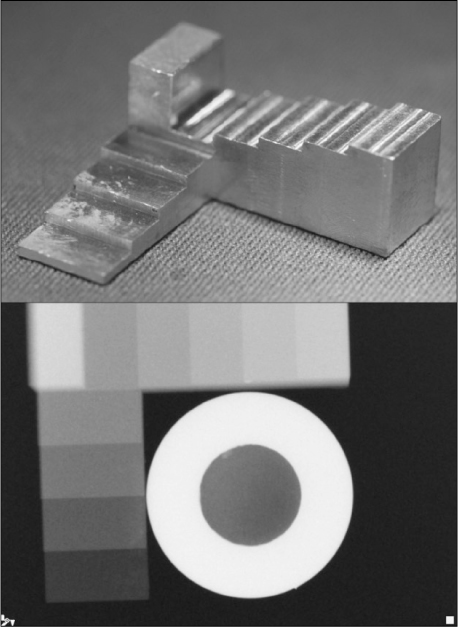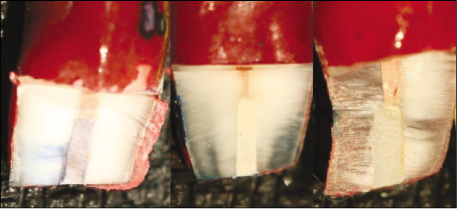J Korean Acad Conserv Dent.
2010 Nov;35(6):445-452. 10.5395/JKACD.2010.35.6.445.
Physical properties of novel composite using Portland cement for retro-filling material
- Affiliations
-
- 1Department of Conservative Dentistry, Pusan National University School of Dentistry, Yangsan, Korea. golddent@pusan.ac.kr
- KMID: 2176466
- DOI: http://doi.org/10.5395/JKACD.2010.35.6.445
Abstract
OBJECTIVES
The aim of this study was to compare apical sealing ability and physical properties of MTA, MTA - AH-plus mixture (AMTA) and experimental Portland cement - Epoxy resin mixture (EPPC) for a development of a novel retro-filling material.
MATERIALS AND METHODS
Forty-nine extracted roots were instrumented and filled with gutta-percha. Apical root was resected at 3 mm and the retro-filling cavity was prepared for 3 mm depth. Roots were randomly divided into 3 groups of 15 roots each. The retro-filling was done using MTA, AMTA, and EPPC as the groups divided. Four roots were used as control groups. After setting in humid condition for 24 hours, the roots were immersed in 1% methylene blue dye solution for 72 hours to test the apical leakage. After immersion, the roots were vertically sectioned and photos were taken to evaluate microleakage. Setting times were measured with Vicat apparatus and digital radiographs were taken to evaluate aluminum equivalent thickness using aluminum step wedge. The results of microleakage and setting time were compared between groups using one-way ANOVA and Scheffe's post-hoc comparison at the significance level of 95%.
RESULTS
AMTA and EPPC showed less microleakage than MTA group (p < 0.05). AMTA showed the highest radio-opacity than other groups and the novel EPPC showed 5 mm aluminum thickness radio-opacity. EPPC showed the shortest initial and final setting times than other groups while the MTA showed the longest (p < 0.05).
CONCLUSIONS
Under the condition of this study, the novel composite using Portland cement-Epoxy resin mixture may useful for retro-filling with the properties of favorable leakage resistance, radio-opacity and short setting time.
Keyword
MeSH Terms
Figure
Reference
-
1. Torabinejad M, Watson TF, Pitt Ford TR. Sealing ability of a mineral trioxide aggregate when used as a root end filling material. J Endod. 1993. 19:591–595.
Article2. Camilleri J, Pitt Ford TR. Mineral trioxide aggregate: a review of the constituents and biological properties of the material. Int Endod J. 2006. 39:747–754.
Article3. Ford TR, Torabinejad M, Abedi HR, Bakland LK, Kariyawasam SP. Using mineral trioxide aggregate as a pulp-capping material. J Am Dent Assoc. 1996. 127:1491–1494.
Article4. Salako N, Joseph B, Ritwik P, Salonen J, John P, Junaid TA. Comparison of bioactive glass, mineral trioxide aggregate, ferric sulfate, and formocresol as pulpotomy agents in rat molar. Dent Traumatol. 2003. 19:314–320.
Article5. Bakland LK. Management of traumatically injured pulps in immature teeth using MTA. J Calif Dent Assoc. 2000. 28:855–858.6. Witherspoon DE, Ham K. One-visit apexification: technique for inducing root-end barrier formation in apical closures. Pract Proced Aesthet Dent. 2001. 13:455–460.7. Holden DT, Schwartz SA, Kirkpatrick TC, Schindler WG. Clinical outcomes of artificial root-end barriers with mineral trioxide aggregate in teeth with immature apices. J Endod. 2008. 34:812–817.
Article8. Banchs F, Trope M. Revascularization of immature permanent teeth with apical periodontitis: new treatment protocol? J Endod. 2004. 30:196–200.
Article9. Camilleri J. The physical properties of accelerated Portland cement for endodontic use. Int Endod J. 2008. 41:151–157.
Article10. Islam I, Chng HK, Yap AU. Comparison of the physical and mechanical properties of MTA and portland cement. J Endod. 2006. 32:193–197.
Article11. Chng HK, Islam I, Yap AU, Tong YW, Koh ET. Properties of a new root-end filling material. J Endod. 2005. 31:665–668.
Article12. Torabinejad M, Hong CU, McDonald F, Pitt Ford TR. Physical and chemical properties of a new root-filling material. J Endod. 1995. 21:349–353.13. Sluyk SR, Moon PC, Hartwell GR. Evaluation of setting properties and retention characteristics of mineral trioxide aggregate when used as a furcation perforation repair material. J Endod. 1998. 24:768–771.
Article14. Wiltbank KB, Schwartz SA, Schindler WG. Effect of Selected Accelerants on the Physical Properties of Mineral Trioxide Aggregate and Portland Cement. J Endod. 2007. 33:1235–1238.
Article15. Ber BS, Hatton JF, Stewart GP. Chemical modification of proroot mta to improve handling characteristics and decrease setting time. J Endod. 2007. 33:1231–1234.
Article16. Asgary S, Shahabi S, Jafarzadeh T, Amini S, Kheirieh S. The properties of a new endodontic material. J Endod. 2008. 34:990–993.
Article17. American Society for Testing and Materials. Standard test method for time of setting of hydraulic cement by Vicat needle. ASTM C191-04. 2004. West Conshohocken, PA: American Society for Testing and Materials.18. Huang TH, Shie MY, Kao CT, Ding SJ. The effect of setting accelerator on properties of mineral trioxide aggregate. J Endod. 2008. 34:590–593.
Article19. Ding SJ, Kao CT, Shie MY, Hung C Jr, Huang TH. The physical and cytological properties of white MTA mixed with Na2HPO4 as an accelerant. J Endod. 2008. 34:748–751.
Article20. Ber BS, Hatton JF, Stewart GP. Chemical modification of ProRoot MTA to improve handling characteristics and decrease setting time. J Endod. 2007. 33:1231–1234.
Article21. Kogan P, He J, Glickman GN, Watanabe I. The effects of various additives on setting properties of MTA. J Endod. 2006. 32:569–572.
Article22. Hsieh SC, Teng NC, Lin YC, Lee PY, Ji DY, Chen CC, Ke ES, Lee SY, Yang JC. A novel accelerator for improving the handling properties of dental filling materials. J Endod. 2009. 35:1292–1295.
Article23. Whitworth JM, Baco L. Coronal leakage of sealer-only backfill: an in vitro evaluation. J Endod. 2005. 31:280–282.
Article24. Leyhausen G, Heil J, Reifferscheid G, Waldmann P, Geurtsen W. Genotoxicity and cytotoxicity of the Epoxy resin based root canal sealer AH plus. J Endod. 1999. 25:109–113.
Article25. Scarparo RK, Grecca FS, Fachin EV. Analysis of tissue reactions to methacrylate resin-based, epoxy resin-based, and zinc oxide-eugenol endodontic sealers. J Endod. 2009. 35:229–232.
Article26. Al-Hiyasat AS, Tayyar M, Darmani H. Cytotoxicity evaluation of various resin based root canal sealers. Int Endod J. 2010. 43:148–153.
Article27. De Almeida WA, Leonardo MR, Tanomaru Filho M, Silva LA. Evaluation of apical sealing of three endodontic sealers. Int Endod J. 2000. 33:25–27.
Article28. Oguntebi BR, Shen C. Effect of different sealers on thermoplasticized Gutta-percha root canal obturations. J Endod. 1992. 18:363–366.
Article29. Kim JC, Kim MR, Ko HJ, Won KY. Apical microleakage of MTA with 4-META/MMA & TBB resin as a root-end filling material. J Korean Acad Conserv Dent. 2009. 34:371–376.
Article30. Coomaraswamy KS, Lumley PJ, Hofmann MP. Effect of bismuth oxide radioopacifier content on the material properties of an endodontic Portland cement-based (MTA-like) system. J Endod. 2007. 33:295–298.
Article31. Ribeiro DA, Duarte MA, Matsumoto MA, Marques ME, Salvadori DM. Biocompatibility in vitro tests of mineral trioxide aggregate and regular and white Portland cements. J Endod. 2005. 31:605–607.
Article32. Islam I, Chng HK, Yap AU. Comparison of the physical and mechanical properties of MTA and portland cement. J Endod. 2006. 32:193–197.
Article33. Chang SW, Yoo HM, Park DS, Oh TS, Bae KS. Ingredients and cytotoxicity of MTA and 3 kinds of Portland cements. J Korean Acad Conserv Dent. 2008. 33:369–376.
Article34. American Society for Testing and Materials. Standard test method for time of setting of hydraulic-cement paste by Gillmore needles. ASTM C266-03. 2003. West Conshohocken, PA: American Society for Testing and Materials.35. International Organization for Standardization. Dental root canal sealing materials. ISO 6876:2001(E). 2001. Geneva, Switzerland: International Organization for Standardization.36. Watts JD, Holt DM, Beeson TJ, Kirkpatrick TC, Rutledge RE. Effects of pH and mixing agents on the temporal setting of tooth-colored and gray mineral trioxide aggregate. J Endod. 2007. 33:970–973.
Article37. Fridland M, Rosado R. Mineral trioxide aggregate (MTA) solubility and porosity with different water-to-powder ratios. J Endod. 2003. 29:814–817.
Article38. Dammaschke T, Gerth HU, Züchner H, Schäfer E. Chemical and physical surface and bulk material characterization of white ProRoot MTA and two Portland cements. Dent Mater. 2005. 21:731–738.
Article39. Saliba E, Abbassi-Ghadi S, Vowles R, Camilleri J, Hooper S, Camilleri J. Evaluation of the strength and radiopacity of Portland cement with varying additions of bismuth oxide. Int Endod J. 2009. 42:322–328.
Article40. Camilleri J. Hydration mechanism of mineral trioxide aggregate. Int Endod J. 2007. 40:462–470.
- Full Text Links
- Actions
-
Cited
- CITED
-
- Close
- Share
- Similar articles
-
- Mineral trioxied aggregate and its substitutes
- A bioactivity study of Portland cement mixed with beta-glycerophosphosphate on human pulp cell
- Cement Burn from Waterproof Work: A Case Study
- Antibacterial Effect on
Enterococcus Faecalis and Physical Properties of Chitosan Added Calcium Hydroxide Canal Filling Material - Effect of pre-heating on some physical properties of composite resin




